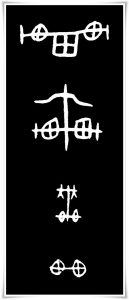
1. Meaning:
vehicle, car
2. Readings:
- Kunyomi (訓読み): くるま
- Onyomi (音読み): シャ
- Japanese names: くら, くろま
- Chinese reading: chē, jū (archaic)
3. Etymology
車 belongs to the 象形文字 (しょうけいもじ, shōkeimoji, i.e., set of characters of pictographic origin). It is a pictograph of a wooden cart, or, more precisely, a Chinese rickshaw.
Some oracle bone script (甲骨文, こうこつぶん, kōkotsubun) forms clearly depict two wheels, a cargo space in between, and a long shaft attached to the yoke of the main structure of the cart (Figure 1). Pre-Han dynasty great seal script forms (籀文, ちゅうぶん, chūbun), including kinbun (金文, きんぶん, i.e. “text on metal”) and even oracle bone script forms, display the same as the above with the addition of two people pulling the rickshaw (similar to those shown in Figure 1 and 2).
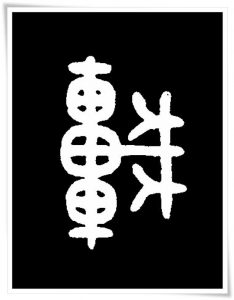
In “Explaining Simple (Characters) and Analyzing Compound Characters” (說文解字, pinyin: Shūowén Jiězì) from the 2nd century C.E., compiled by Xu Shen (許慎, Xǔ Shèn, ca. 58 C.E. – ca. 147 C.E.), a philologist of the Han dynasty (漢朝, 206 B.C. – 220 C.E.), we find a definition of 車, stating that it is a cart equipped with a seat(s) (human pulled carriage or sedan chair on wheels). Xu shen also indicates that rickshaws were already being manufactured during the first historically confirmed dynasty of China, the Xia dynasty (夏朝, pinyin: Xià Cháo, ca. 2070 – ca. 1600 B.C.).
According to archeological data, the wheel was invented around 8000 B.C., approximately 6400 years before the kinbun and oracle bone scripts were developed. This confirms the accuracy of the presence of the wheel pictograph in virtually every form of the character 車.

4. Selected historical forms of 車.
Figure 1. Various forms of the character 車 in oracle bone script (甲骨文, こうこつぶん, kōkotsubun, c.a.1600 B.C. – 800 B.C.).
Figure 2. Seal script (篆書, てんしょ, tensho) form of the character 車, from works by the famous seal script scholar and calligrapher Wu Dacheng (呉大澂, pinyin: Wú Dàchéng, 1835 – 1902 C.E.), Qing dynasty (清朝, pinyin: Qīng cháo, 1644 – 1912 C.E.).
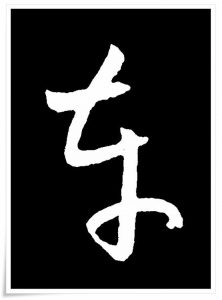
Figure 3. Clerical script (隷書, れいしょ, reisho) form of the character車. This ink rubbing comes from the rock carving named Shi xia song (西狹頌pinyin: Shī xiá sòng), erected during the late Han dynasty (漢朝, 206 B.C. – 220 C.E.), 171 C.E. Shi xia song is one of the most preferred texts for studying rinsho (臨書, りんしょ, i.e. “copying [studying] masterpieces”) of the clerical script.
Figure 4. Cursive script (草書, そうしょ, sōsho) form of the character 車, found in the famous Thousand Character Classic (千字文, pinyin: Qiān zì wén). Tis particular copy is attributed to the Tang Dynasty (唐朝, 618 – 907 C.E.) calligrapher, 欧陽詢 (Ōu Yángxún, 557 – 641).
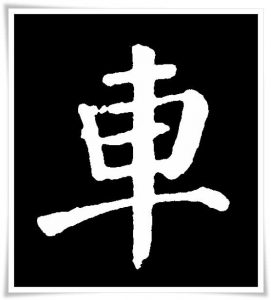
Figure 5. Standard script (楷書, かいしょ, kaisho) form of the character 車, from the stele Yan Qinli bei (顔勤禮碑, pinyin: Yán Qínlǐ bēi) by Yan Zhenqing (顔真卿, pinyin: Yán Zhēnqīng, 709 – 785) of the Tang Dynasty (唐朝, pinyin: Táng Cháo, 618 – 907 C.E.).
Figure 6. Semi-cursive script (行書, ぎょうしょ, gyōsho) form of the character 車, from a masterpiece by the ink painter and calligrapher of the The Song Dynasty (宋朝; pinyin: Sòng Cháo, 960 – 1279 C.E.) Mi Fu (米黻, pinyin: Mǐ Fú, 1051–1107 C.E.), also known as Mi Fei (米芾, pinyin: Mǐ Fèi).
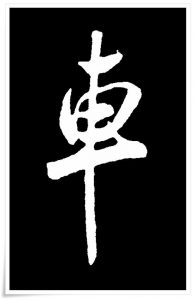
5. Useful phrases
- 車庫 (しゃこ, shako) – garage
- 外車 (がいしゃ, gaisha) – foreign car
- 空車 (くうしゃ, kūsha) – free taxi, parking lot with available spaces
- 車検 (しゃけん, shaken) – periodical mandatory car check-up
- 車内 (しゃない, shanai) – inside the car
